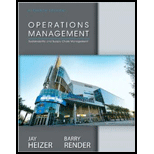
To explain: The layout strategies.
Explanation of Solution
The seven layout strategies are as follows:
- Office layout
Locate office workers close to each other who require frequent contact for carrying out their work. To illustrate, the secretary of the CEO should have a desk as close to the CEO’s room as possible. The Corporate Planning Manager’s workplace cannot be too far from the CEO’s room.
- Retail layout
The shelf space and the shelf location depend on customer requirements and convenience. A customer should find it convenient to locate what he is looking for in a supermarket.
- Warehouse layout
In a warehouse, layouts aim at optimizing the volume of warehouse space usage and the convenience of storage and retrieval. The warehouse layout should keep in view usage of material handing equipment such as forklift trucks, pallet trucks, cranes and so on.
- Project or fixed position
In a shipbuilding yard, the position of the ship being built is fixed. Workers and equipment move to the work area.
- Process-oriented layout
A typical job shop may have metal cutting machine tools such as lathes, milling machines, drilling machines, grinding machines and so on. To process each job, the extent of requirements of time from different groups of machine tools may vary. Some jobs may require more of lathe work. Some others may require more of grinding work and so on. The layout will normally have clusters of machines such as a few lathes, at one location, a few grinding machines may be in a different location and so on.
- Work cells
Typically in manufacturing industry, a family of products or a category of items with similar characteristics may require special arrangement of machines and operators so that the work is done efficiently. Normally these machines may be dispersed on the shop floor and for creating a work cell, they are brought together.
- Repetitive or continuous
Layouts for products that require high volume output and are of less variety often have specialized equipment or “special purpose machines” which are laid out sequentially. Manufacturing facilities for bearings, automobile tires, consumer durables and so on have typical layouts which can be categorized as “repetitive or continuous” layouts.
Want to see more full solutions like this?
Chapter 9 Solutions
Operations Management
- Provide a warehouse layout for cell phone products and an explanation of the factors of the layout design for the product (industry)?arrow_forwardDescribe the importance of layout planning for a business and what are the consequences of a poor layout?arrow_forwardDescribe the differences among product, process, and group technology layouts.Describe the circumstances in which each type of layout is appropriatearrow_forward
- Explain product layouts and their primary benefits and drawbacks.arrow_forwarddiscuss layout decisions affect a wide range of facilities, from factories, supermarkets, offices, department stores, and warehouses, to malls, parking lots and garages, and kitchens. Layout is also important in the design of some products such as the interiors of automobiles and the arrangement of components inside computers and other electronic devices. Select three different items from this list, or other similar items, and explain for each what the four or five key considerations for layout design are.arrow_forwardDescribe the layout that think would be best for attracting and serving customers for a home furnishings store.arrow_forward
- When designing a DC, what interior layout objectives and slotting principles must be considered?why?arrow_forwardWhat is a systematic layout planning and discuss it's benefits ?arrow_forwardDescribe three facility layout methods, identify one business example of each of the methods in detail? Then explain why that business would choose those particular layout methods?arrow_forward
 Practical Management ScienceOperations ManagementISBN:9781337406659Author:WINSTON, Wayne L.Publisher:Cengage,
Practical Management ScienceOperations ManagementISBN:9781337406659Author:WINSTON, Wayne L.Publisher:Cengage, Operations ManagementOperations ManagementISBN:9781259667473Author:William J StevensonPublisher:McGraw-Hill Education
Operations ManagementOperations ManagementISBN:9781259667473Author:William J StevensonPublisher:McGraw-Hill Education Operations and Supply Chain Management (Mcgraw-hi...Operations ManagementISBN:9781259666100Author:F. Robert Jacobs, Richard B ChasePublisher:McGraw-Hill Education
Operations and Supply Chain Management (Mcgraw-hi...Operations ManagementISBN:9781259666100Author:F. Robert Jacobs, Richard B ChasePublisher:McGraw-Hill Education
 Purchasing and Supply Chain ManagementOperations ManagementISBN:9781285869681Author:Robert M. Monczka, Robert B. Handfield, Larry C. Giunipero, James L. PattersonPublisher:Cengage Learning
Purchasing and Supply Chain ManagementOperations ManagementISBN:9781285869681Author:Robert M. Monczka, Robert B. Handfield, Larry C. Giunipero, James L. PattersonPublisher:Cengage Learning Production and Operations Analysis, Seventh Editi...Operations ManagementISBN:9781478623069Author:Steven Nahmias, Tava Lennon OlsenPublisher:Waveland Press, Inc.
Production and Operations Analysis, Seventh Editi...Operations ManagementISBN:9781478623069Author:Steven Nahmias, Tava Lennon OlsenPublisher:Waveland Press, Inc.





